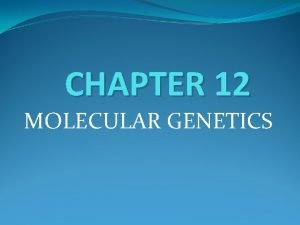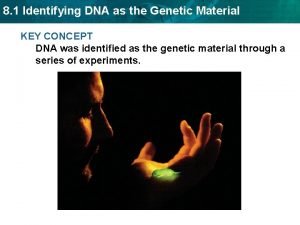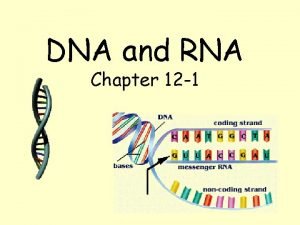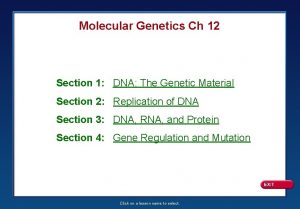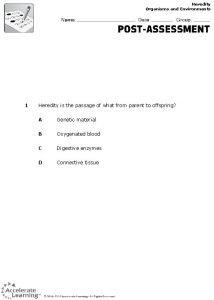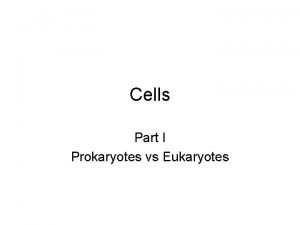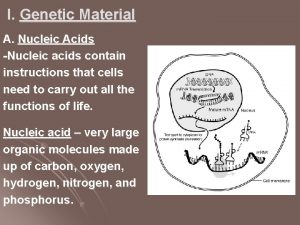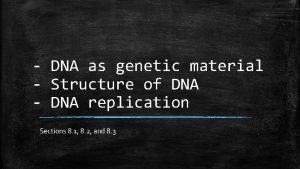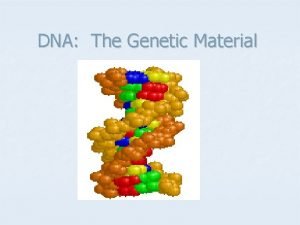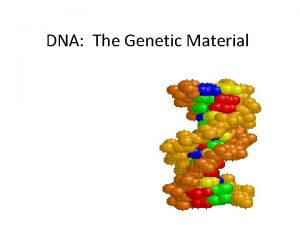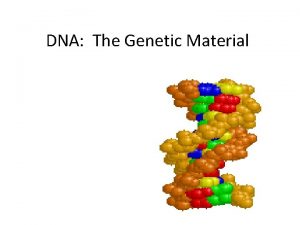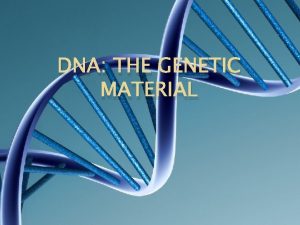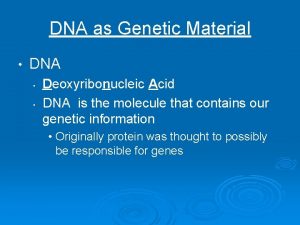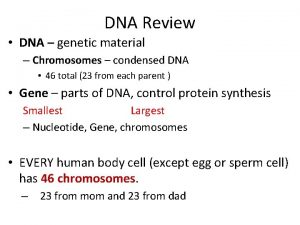DNA The Genetic Material Section 12 1 Structure















- Slides: 15

DNA: The Genetic Material Section 12 -1: Structure of DNA

Learning Targets • I can… 1. Describe experiments that led to the understanding of the structure of DNA 2. Model the structure and function of DNA

The Discovery • 1928 – 1944 – Frederick Griffith and Oswald Avery determined that DNA is the genetic material while working with vaccines. • 1950 s – It was generally accepted that genes are made of DNA – James Watson and Francis Crick pieced together the structure of DNA James Watson & Francis Crick

DNA Structure • DNA is a double helix molecule. • What is a double helix? – Double Helix: two strands twisted around each other like a winding staircase • Think of a ladder that twists around.

DNA Structure • Each strand is made up of nucleotides. – Nucleotide: subunits that make up DNA • 3 Parts of a nucleotide: 1. Phosphate group 2. 5 -carbon sugar molecule 3. Nitrogen containing base • 5 -carbon sugar – called deoxyribose • “DNA” = deoxyribonucleic acid

DNA Structure • Sugar and phosphate groups are the same for all nucleotides – Nitrogen bases can change • 4 Possible Nitrogen Bases: 1. 2. 3. 4. Adenine (A) Guanine (G) Thymine (T) Cytosine (C)

DNA Structure 2 Types of nitrogen bases– Purines vs. Pyrimidines • Purines: made of two rings containing nitrogen and carbon atoms • Pyrimidines: made of a single ring of nitrogen and carbon atoms – Purines = Adenine and Guanine {A & G} – Pyrimidines = Thymine and Cytosine {T & C}

DNA Structure • Sugar and phosphate groups = “side rails” of DNA “ladder” • Paired nitrogen bases = “rungs” or steps of DNA “ladder” • Nitrogen bases face each other and are attracted by weak hydrogen bonds, which holds the double helix together

DNA Structure • Other scientists contributed to the discovery of DNA’s structure 1. Ervin Chargaff (1949) a. In every organism, the amount of adenine always equals the amount of thymine (A = T) b. In every organism, the amount of guanine always equals the amount of cytosine (G = C)

DNA Structure • Other Scientists cont. 2. Maurice Wilkins and Rosalind Franklin (1952) a. Used a method called x-ray diffraction to take pictures of DNA molecules. b. Showed that DNA resembled a tightly coiled helix composed of chains of nucleotides

DNA Structure: • Other Scientists cont. 3. Watson and Crick (1953) a. Used Chargaff, Wilkins, and Franklin’s observations b. Built a tin-and-wire model 2 Components: 1. Double Helix (“spiral staircase”) of nucleotides twisted around a central axis a. Supported Wilkins and Franklin 2. Pairing Between Bases a. Supported Chargaff

DNA Structure • Base-Pairing Rules – Adenine always pairs with Thymine • A – T or T – A – Guanine always pairs with Cytosine • G – C or C – G • The two strands of nucleotides making up a DNA molecule are complementary – The sequence of bases on one side determine the sequence on the other strand.

Practice Pairing Bases • #1)Below is one side of a strand of DNA. Based on the base-pairing rules, what would the other strand look like?

Practice Pairing Bases • Below is one side of a strand of DNA. Based on the base-pairing rules, what would the other strand look like?

Practice Pairing Bases Practice pairing nitrogen bases by completing the following strands. Find the complimentary bases. Example #2: TCGAACT Answer #2 AGCTTGA Example #3: CTTAGGCT Answer #3 GAATCCGA
 Chapter 12 section 1 dna the genetic material
Chapter 12 section 1 dna the genetic material Chapter 12 section 1 dna the genetic material
Chapter 12 section 1 dna the genetic material Chapter 12 section 1 molecular genetics answer key
Chapter 12 section 1 molecular genetics answer key Section 12-1 dna
Section 12-1 dna Section 1 identifying dna as the genetic material
Section 1 identifying dna as the genetic material On and off
On and off Chapter 12 section 1 the genetic material
Chapter 12 section 1 the genetic material Founder effect vs gene flow
Founder effect vs gene flow Genetic programming vs genetic algorithm
Genetic programming vs genetic algorithm Genetic programming vs genetic algorithm
Genetic programming vs genetic algorithm What is gene flow and genetic drift
What is gene flow and genetic drift Gene flow vs genetic drift
Gene flow vs genetic drift Heredity is best described as the
Heredity is best described as the Chapter 3 cells and tissues figure 3-7
Chapter 3 cells and tissues figure 3-7 Which part of the cell contains genetic material
Which part of the cell contains genetic material Genetic material
Genetic material



